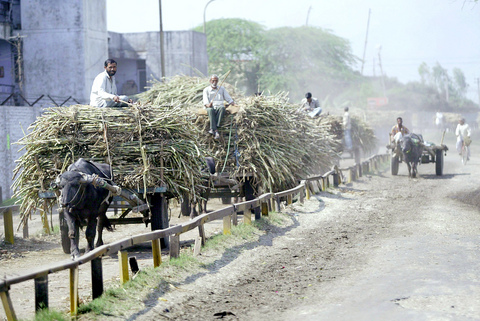Indians know better than to eat the plum-sized fruit of the wild jatropha bush. It's poisonous enough to kill.
But with oil prices surging, the lowly jatropha is experiencing a renaissance of sorts -- as a potential source for fuel for trucks and power stations. The government has identified 39.2 million hectares of land where jatropha can be grown, hoping it will replace 20 percent of diesel consumption in five years.
"We have found that we can produce biodiesel from it. If we can keep the price down, the future looks bright," said R.K. Malhotra, who oversees the Indian Oil Corp's research center that is running tests on the oil.

PHOTO: AP
India isn't alone. All across Asia, governments are searching for crops that can help them offset a dependence on imported oil that can only skyrocket as their economies soar. Palm oil and sugar cane are the dominant crops in the region, but everything from coconuts to castor oil to cow dung is being tested for fossil-fuel alternatives such as ethanol and biodiesel.
Most experts also believe that, using current technologies, there isn't enough land to make a serious dent in oil consumption. Some scientists say production will consume more conventional energy than it will save, and environmentalists came out this month against plans by Indonesia to convert millions of hectares of rain forest on the island of Borneo into palm oil plantations.
Georgia Tech professor Arthur Ragauskas, who co-authored a study of biofuels that was published in Science magazine, sees other potential pitfalls.
"One criticism of biofuels is that if you want to go from 2 percent to 20 percent, you would have to direct so much of that agriculture from food to fuel that there would be real competition between the two," he said in a telephone interview.
"Even worse, if we have a famine in part of the world, we would have to make a decision as a society between food or fuel," he said.
For now, alternative fuels are less than 1 percent of current fuel usage in most of Asia, and experts say their large-scale use is years if not decades away.
Still, "Every country in Asia is trying to commercialize and put up legislation on biofuels," said Conrado Heruela, a renewable energy specialist with the UN Food and Agriculture Agency.
"Right now, the target is not that big but it will be very significant in the long term," he said.
On some Pacific islands, whose isolation makes oil imports more costly and vulnerable to market shifts, power companies are looking for other sources.
"The use of alternative fuels is very much the topic of the moment among the small utilities in the Pacific," said Jean Chaniel, the general manager of Unelco Vanuatu, whose company runs some generators on 5 percent coconut oil.
The Fiji Electricity Authority plans to switch entirely to renewable energy by 2011.
India says it wants to increase its use of renewable energy from the current 5 percent to 25 percent by 2030. Much of this will come from nuclear plants, but it is also examining wind power and other methods including jatropha.
About half of India drives on gasoline with 5 percent ethanol, and the government aims to increase that to 20 percent in the next decade.

The US government has signed defense cooperation agreements with Japan and the Philippines to boost the deterrence capabilities of countries in the first island chain, a report by the National Security Bureau (NSB) showed. The main countries on the first island chain include the two nations and Taiwan. The bureau is to present the report at a meeting of the legislature’s Foreign Affairs and National Defense Committee tomorrow. The US military has deployed Typhon missile systems to Japan’s Yamaguchi Prefecture and Zambales province in the Philippines during their joint military exercises. It has also installed NMESIS anti-ship systems in Japan’s Okinawa

‘WIN-WIN’: The Philippines, and central and eastern European countries are important potential drone cooperation partners, Minister of Foreign Affairs Lin Chia-lung said Minister of Foreign Affairs Lin Chia-lung (林佳龍) in an interview published yesterday confirmed that there are joint ventures between Taiwan and Poland in the drone industry. Lin made the remark in an exclusive interview with the Chinese-language Liberty Times (the Taipei Times’ sister paper). The government-backed Taiwan Excellence Drone International Business Opportunities Alliance and the Polish Chamber of Unmanned Systems on Wednesday last week signed a memorandum of understanding in Poland to develop a “non-China” supply chain for drones and work together on key technologies. Asked if Taiwan prioritized Poland among central and eastern European countries in drone collaboration, Lin

NO CONFIDENCE MOTION? The premier said that being toppled by the legislature for defending the Constitution would be a democratic badge of honor for him Premier Cho Jung-tai (卓榮泰) yesterday announced that the Cabinet would not countersign the amendments to the local revenue-sharing law passed by the Legislative Yuan last month. Cho said the decision not to countersign the amendments to the Act Governing the Allocation of Government Revenues and Expenditures (財政收支劃分法) was made in accordance with the Constitution. “The decision aims to safeguard our Constitution,” he said. The Constitution stipulates the president shall, in accordance with law, promulgate laws and issue mandates with the countersignature of the head of the Executive Yuan, or with the countersignatures of both the head of the Executive Yuan and ministers or

CABINET APPROVAL: People seeking assisted reproduction must be assessed to determine whether they would be adequate parents, the planned changes say Proposed amendments to the Assisted Reproduction Act (人工生殖法) advanced yesterday by the Executive Yuan would grant married lesbian couples and single women access to legal assisted reproductive services. The proposed revisions are “based on the fundamental principle of respecting women’s reproductive autonomy,” Cabinet spokesperson Michelle Lee (李慧芝) quoted Vice Premier Cheng Li-chiun (鄭麗君), who presided over a Cabinet meeting earlier yesterday, as saying at the briefing. The draft amendment would be submitted to the legislature for review. The Ministry of Health and Welfare, which proposed the amendments, said that experts on children’s rights, gender equality, law and medicine attended cross-disciplinary meetings, adding that